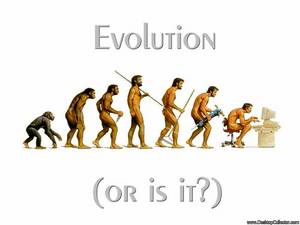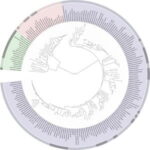Human beings belong under the mammalian order Primates. Members of the primates have some salient features and man is the finest product yet arisen through the slow but dynamic evolutionary changes. Three important features that human beings share with the other Primates are : 1) The development of opposable thumbs, opposable great toes and flattened finger nails. According to Pough et al. (1996) “Man is descended from arboreal ancestors that lived in early Tertiary forests 65 million years ago. Our closest extant relatives are the Chimpanzees and Gorillas of Africa.
Apes and Modern Man :
It was a very general believe that Apes were ancestors of man. Apes and man although belong to the same superfamily Hominoidea are placed in two separate families- Pongidae and Hominidae. However, they differ distinctly in some important features given below :
1. Apes have strong Nuchal crest but Man has low nuchal crest.
2. Apes have Prognathous skull but man has orthognathous skull.
3. In Apes, projecting eye brow ridges are present, but in man man has no projecting eye brow ridges.
4. Apes have cranial capacity about 750 c.c. but man has cranial capacity is about 2200 c.c.
5. In Apes, all the teeth specially, incisor and canine are long, but in man, all the teeth including incisors and canine are reduced in length.
Evolutionary trends in MAN :
Several features that describes the evolutionary pathway of man from other anthropoids are given below :
1. Large cranial capacity in modern man.
2. Dental arch is a smoothly rounded parabola.
3. Canine teeth not projected beyond other teeth.
4. Simian gap and simian shelf absent.
5. Orthognathous skull with high forehead without projecting eye-brow ridges.
6. Upright posture with bipedal locomotion, reflected in the structures of skull, vertebral column, pelvis and legs.
Early Evolution of Primates :
Evolution of man, apes started since Oligocene and a common stock has been recognized in Propliopithecus. In Miocene a group od apes known called Dryopithecus were evolved. Evolutionary sequence leading to man, gorilla and other apes originated diverging from Dryopithecus.
Dryopithecus have a generalized arm structure from which both man and apes might have been originated. In late Miocene Shivapithecus, Ramapithecus etc. were originated those have few similar features with modern man.
Origin of Australopithecus:
Some evidences indicate that by early Pleistocene period Hominids had attained an upright posture though they retained ape like brains. Thus, from Pleistocene period Apes and man began to walk in two different lines.
The earliest hominids are known as Australopithecus. The features of this form are :
1. An upright posture is present.
2. Dental arch is smoothly rounded parabola.
3. No simian gap and canine teeth not projecting other teeth.
4. Position of Foramen Magnum forward under the base of the skull.
5. Eye brow ridges projected over eyes.
6. Cranial capacity : 450-600 ml.
NOTE :
Australopithecus thus had a mosaic form of man and ape like features. Point no. 1 to 4 are similar with modern man but point no. 5 and 6 are ape like.
There are several types of Australopithecus, like Gracile type (Australopithecus africanus), Robust type (Australopithecus robustus), Lucy (Australopithecus afferensis) etc.
Gracile type had lightly body structure indicating an omnivorous form but Robust type had strong cheek teeth indicating a herbivorous diet.
Origin of Genus Homo, Homo erectus :
In the middle Pleistocene “erect ape man” or Java man and Peking man was originated.
Since both shared basic features were included in the genus Homo– Homo erectus.
The features of Homo erectus are :
1. These form walked upright.
2. Flat skull with little or no forehead.
3. Cranial capacity – In Java man : 775-900 c.c.; In Peking man : 915-1225 c.c.
4. Prognathus skull.
5. Larger teeth and eye brow ridges.
NOTE : Homo erectus were not only confined to the Asia but were also spreaded through the Africa as Homo habilis.
Origin of Homo sapiens :
Some transitional forms show a tend from Homo erectus towards the two types of man found in later deposits of Pleistocene.
These transitional forms sometimes now classified in our own species i.e. Homo sapiens. From the different assembledge of transitional forms of some 200,000 years ago very distict groups evolved : Neanderthal man and modern man. However, Neanderthal man regarded as a subspecies in our species as Homo sapiens neanderthalensis.
During the first portions of the fourth or last glaciation, distinctive groups of man collectively known as Neanderthal ( or Neandertal) man lived in Europe. Features of this type of man are :
1. Forehead low and slanting.
2. Heavy eye brow ridges.
3. Height of the body is less than modern man.
4. Cranial capacity is about 1200-1600 c.c.
5. used tools.
Neanderthal man were succeded by Homo sapiens of modern time, the first of these were the Cro-Mognon Man. They were :
1. Taller than Neanderthal man.
2. Orthognathous skull like modern man.
3. Teeth and jaw like modern man.
Cro-mognon man later evolved into modern man (Homo sapiens sapiens). Eventually stone age was replaced by Bronze age, and that by Iron age and Homo sapiens sapiens is still getting more complex structures and evolution of man is now also going on.
Further Readings May Be Done From :
1. Evolution : Second edition, M. W. Srickberger., U.S.A.
2. Vertebrate Life : Fourth edition, F. H. Pough, J.B. Heiser and W.N. Mcfarland.
3. Oxford Dictionary for Biology : Fourth edition : Oxford University Press.





